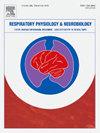Integration of CO2 clearance and continuous neurally adjusted ventilatory assist in an animal model of respiratory distress
IF 1.6
4区 医学
Q3 PHYSIOLOGY
引用次数: 0
Abstract
Background
A mode of ventilation is introduced that integrates CO2 clearance (“Through-Flow”, TF) with Continuous Neurally Adjusted Ventiator Assist (cNAVA). The new mode, referred to as “TF+cNAVA”, is a unidirectional flow system where inspiratory lumen(s) within an ET tube delivers fresh gas at the carina and the main ET tube lumen allows overflow of fresh gas to provide assist in proportion to the electrical activity of the diaphragm (Edi). The aim was to evaluate the effect of TF+cNAVA on breathing parameters during respiratory provocations, its reproducibility, and its sustainability. Conventional NAVA was the comparison.
Methods
46 rabbits were studied in three protocols: (i) NAVA vs. TF+cNAVA in open chest with added dead space, acute lung injury (ALI), single lung ventilation, and vagotomy (n = 8); (ii) Eight repeated comparisons, to demonstrate reproducibility (n = 8); (iii) ALI rabbits (n = 30) randomized to either NAVA or TF+cNAVA (6 h). Parameters studied: Edi, tidal volume (VT), breathing frequency (FB), minute ventilation (VE), transpulmonary pressure (PL), and PaCO2.
Results
With added provocations, NAVA showed an increase in Edi, VT, FB, PL and VE from baseline by 43 % (P = 0.004). TF+cNAVA significantly reduced Edi, VT, FB, PL, and VE from baseline, by 73 % (P < 0.001). In NAVA vs. TF+cNAVA crossover, TF+cNAVA consistently reached apneic levels for Edi, VT, FB, PL, and VE. During 6 h of TF+cNAVA, PaCO2, Edi, VT, FB, PL, and VE were significantly reduced compared to NAVA and baseline.
Conclusion
TF+cNAVA unloads respiratory muscles and suppresses respiratory drive, while reducing lung distending pressure.
在呼吸窘迫动物模型中CO2清除和连续神经调节通气辅助的整合。
背景:介绍了一种将CO2清除(“Through-Flow”,TF)与连续神经调节通气辅助(Continuous neural Adjusted Ventiator Assist, cNAVA)相结合的通气模式。这种新模式被称为“TF+cNAVA”,是一种单向流动系统,在这种系统中,ET管内的吸气腔将新鲜气体输送到carina,而主ET管腔允许新鲜气体溢出,以提供与隔膜(Edi)的电活动成比例的辅助。目的是评估TF+cNAVA对呼吸刺激期间呼吸参数的影响,其再现性和可持续性。常规NAVA作为对照。方法:对46只家兔进行3种治疗方案的研究:(i) NAVA与TF+cNAVA在开胸增加死腔、急性肺损伤(ALI)、单肺通气和迷走神经切开术(n = 8);8次重复比较,以证明可重复性(n = 8);(iii) ALI兔(n=30)随机分为NAVA组或TF+cNAVA组(6小时)。研究参数:Edi、潮气量(VT)、呼吸频率(FB)、分气量(VE)、转肺压(PL)、PaCO2。结果:随着挑衅的增加,NAVA显示Edi、VT、FB、PL和VE较基线增加43% (P=0.004)。与基线相比,TF+cNAVA显著降低了Edi、VT、FB、PL和VE,降低了73% (PT、FB、PL和VE)。在TF+cNAVA治疗的6小时内,PaCO2、Edi、VT、FB、PL和VE与NAVA和基线相比显著降低。结论:TF+cNAVA可减轻呼吸肌负荷,抑制呼吸驱动,降低肺扩张压。
本文章由计算机程序翻译,如有差异,请以英文原文为准。
求助全文
约1分钟内获得全文
求助全文
来源期刊
CiteScore
4.80
自引率
8.70%
发文量
104
审稿时长
54 days
期刊介绍:
Respiratory Physiology & Neurobiology (RESPNB) publishes original articles and invited reviews concerning physiology and pathophysiology of respiration in its broadest sense.
Although a special focus is on topics in neurobiology, high quality papers in respiratory molecular and cellular biology are also welcome, as are high-quality papers in traditional areas, such as:
-Mechanics of breathing-
Gas exchange and acid-base balance-
Respiration at rest and exercise-
Respiration in unusual conditions, like high or low pressure or changes of temperature, low ambient oxygen-
Embryonic and adult respiration-
Comparative respiratory physiology.
Papers on clinical aspects, original methods, as well as theoretical papers are also considered as long as they foster the understanding of respiratory physiology and pathophysiology.

 求助内容:
求助内容: 应助结果提醒方式:
应助结果提醒方式:


